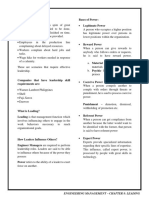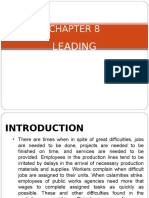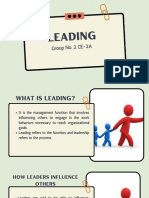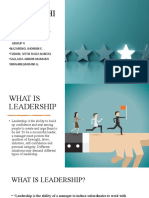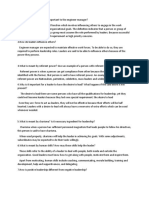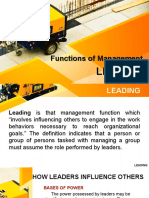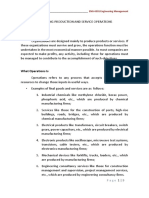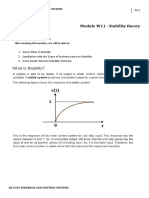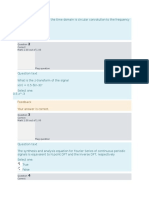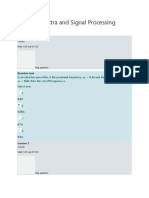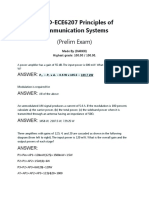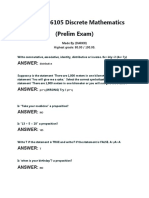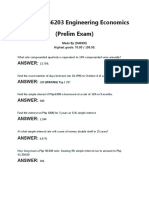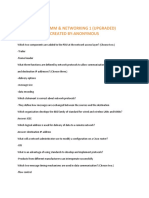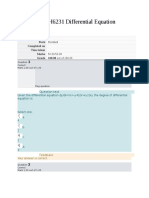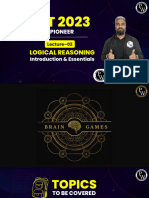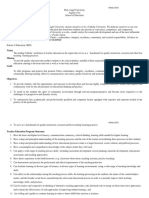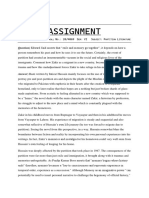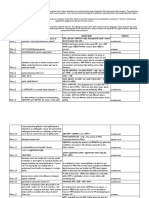MODULE OF INSTRUCTION______________________________ ENG-6301 Engineering Management
LEADING
Introduction
Successful firms regard the leadership skill requirement as a high
priority concern. Big companies like Warner Lambert Philippines, Shell, Fuji-
Xerox, and Daewoo are seriously involved in training their managers to
become effective leaders.
What is Leading?
Leading is the management function which involves influencing others to
engage in the work behaviors necessary to reach organizational goals. The definition
indicates that a person or group of persons tasked with managing a group must
assume the role performed by leaders.
While leading refers to the function, leadership refers to the process.
How Leaders Influence Others
Engineer managers are expected to maintain effective work forces.
To be able to do so, they are required to perform leadership roles. Leaders
are said to be able to influence others because of the power they possess.
Power refers to the ability of a leader to exert force on another.
Bases of Power
The power possessed by leaders may be classified according to
various bases. They are as follows:
1. Legitimate Power – a person who occupies a higher position
has legitimate power over persons in lower position within the
organization.
Page 1|8
�MODULE OF INSTRUCTION______________________________ ENG-6301 Engineering Management
2. Reward Power – when a person has the ability to give rewards
to anybody who follows orders or requests. (material or
psychic/praises, recognition)
3. Coercive Power – when a person compels another to comply
with orders through threats or punishment.
4. Referent Power – when a person can get compliance form
another because the latter would want to be identified with
the former.
5. Expert Power – provide specialized information regarding
their specific lines of expertise.
The Nature of Leadership
Leadership may be referred to as the process of influencing and
supporting others to work enthusiastically toward achieving objectives.
Leadership is expected of any manager in charge of any unit or division.
Once cannot expect a unit or division to achieve objectives in the
absence of effective leadership. Even if a leader is present, but if he is not
functioning properly, no unit or division objectives can be expected to be
achieved.
Traits of Effective Leaders
There are certain leadership traits identified by researchers and which may
be useful in developing effective leaders. These traits are as follows:
1. A high level of personal drive
2. The desire to lead
3. Personal integrity
4. Self-confidence
5. Analytical ability or judgment
6. Knowledge of the company, industry or technology
Page 2|8
�MODULE OF INSTRUCTION______________________________ ENG-6301 Engineering Management
7. Charisma
8. Creativity
9. Flexibility
1. Personal Drive – persons with drive are those identified as willing to
accept responsibility, possess vigor, initiative, persistence, and
health.
2. The Desire to Lead - Leaders with desire to lead will always have a
reservoir of extra efforts which can be used whenever needed.
3. Personal Integrity – a person who is well-regarded by others as one
who has integrity possesses one trait of a leader.
4. Self-Confidence – the activities of leaders require moves that will
produce the needed outputs.
5. Analytical Ability – the ability to analyze is one desirable trait that a
leader can use to tide him over many challenging aspects of
leadership.
6. Knowledge of the Company, Industry or Technology – a leader who is
well-informed about his company, the industry where the company
belongs, and the technology utilized by the industry, will be in a better
position to provide directions to his unit.
7. Charisma – when a person has sufficient personal magnetism that
leads people to follow his directives.
8. Creativity – Ronnie Millevo defines creativity as the ability to combine
existing data, experience, and preconditions from various sources in
such a way that the results will be subjectively regarded as new,
valuable, and innovative, and as a direct solution to an identified
problem situation.
9. Flexibility – one will adapt a different method from another person’s
method.
Page 3|8
�MODULE OF INSTRUCTION______________________________ ENG-6301 Engineering Management
Leadership Skills
Leaders need to have various skills to be effective they are:
1. Technical skills – these are skills a leader must possess to
enable him to understand and make decisions about work
processes, activities, and technology.
2. Human skills – these skills refer to the ability of a leader to deal
with people, both inside and outside the organization.
3. Conceptual skills – these skills refer to the ability to think in
abstract terms, to see how parts fit together to form the
whole.
Behavioral Approaches to Leadership Styles
Those in position of leadership exhibit a pattern of behavior that is
unique and different from other patterns. This total pattern of behavior is
called leadership style.
There are several approaches used in classifying leadership styles.
They are as follows:
1. According to the ways leaders approach people to motivate
them.
2. According to the way the leader uses power.
3. According to the leader’s orientation towards task and people.
Ways Leaders Approach People
There are two ways, a leader may approach people to motivate them.
They are:
1. Positive leadership – when the leader’s approach emphasizes
rewards.
Page 4|8
�MODULE OF INSTRUCTION______________________________ ENG-6301 Engineering Management
2. Negative leadership – when punishment is emphasized by the
leader.
Ways Leaders Uses Power
Leadership styles also vary according to how power is used. They are
as follows:
1. Autocratic Leaders – leaders who make decisions themselves,
without consulting subordinates. (its disadvantages is that the
leader receives little, if any, information and ideas from his
people as inputs into his decision-making)
2. Participative Leaders – when a leader openly invites his
subordinates to participate or share in decisions, policy-
making and operation methods.
3. Free-Rein Leaders – leaders who set objectives and allow
employees or subordinates relative freedom to do whatever
it takes to accomplish these objectives.
Leaders Orientation Towards Tasks and People
Leaders may be classified according to how they view tasks and
people. Consequently, a leader may either be:
1. Employee Orientation – a leader is said to be employee-
oriented when he considers employees as human beings of
intrinsic importance and with individual and personal need to
satisfy.
2. Task Orientation – a leader is said to be task-oriented if he
places stress on production and the technical aspects of the
job and the employees are viewed as the means of getting the
work done.
Page 5|8
�MODULE OF INSTRUCTION______________________________ ENG-6301 Engineering Management
Contingency Approaches to Leadership Style
The contingency approach is an effort to determine through research
which managerial practices and techniques are appropriate in specific
situations. The various contingency approaches are as follows:
1. Fiedler’s Contingency Model
2. Hersey and Blanchard’s Situational Leadership Model
3. Path-Goal Model of Leadership
4. Vroom’s Decision Making Model
• Fiedler’s Contingency Model
• According to Fred Fiedler, leadership is effective when the
leader’s style is appropriate to the situation. The situational
characteristics is determined by three principal factors:
1. The relations between leaders and followers
2. The structure of the task, and
3. The power inherent in the leader’s position.
• The situational characteristics vary from organization to
organization. To be effective, the situation must fit the leader.
If this is not so, the following may be tried:
1. Change the leader’s traits or behaviors
2. Select leaders who have traits or behaviors fitting the
situation.
3. Move leaders around in the organization until they are
in positions that fit them
4. Change the situation
Page 6|8
�MODULE OF INSTRUCTION______________________________ ENG-6301 Engineering Management
Hersey and Blanchard’s Situational Leadership Model
• The situational leadership model suggests that the most important
factor affecting the selection of a leader’s style is the development
(or maturity) level of subordinate. The leader should match his or her
style to this maturity level.
• Maturity has two components:
1. Job skills and knowledge
2. Psychological maturity
• Blanchard and others elaborated on the leadership styles appropriate
for the various maturity level of subordinates. They are as follows:
• Style 1: Directing – id for people who lack competence but are
enthusiastic and committed.
Path-Goal Model of Leadership
Leadership can be made effective because leaders can influence
subordinate’s perceptions of their work goals, personal goals, and paths to
goal attainment.
By using the path-goal model, it is assumed that effective leaders can
enhance subordinate motivation by:
1. Clarifying the subordinate’s perception of work goals
2. Linking meaningful rewards with goal attainment
3. Explaining how goals and desired rewards can be achieved
Leadership Styles – which may be used by path-goal are as follows:
1. Directive leadership – where the leader focuses on clear task
assignments, standards of successful performance, and work
schedules.
Page 7|8
�MODULE OF INSTRUCTION______________________________ ENG-6301 Engineering Management
2. Supportive leadership – where subordinates are treated as
equals in a friendly manner while striving to improve their
well-being.
3. Participative leadership – where the leader consults with the
subordinates to seek their suggestions and then seriously
considers those suggestions when making decisions.
4. Achievement-oriented leadership – where the leader set
challenging goals, emphasize excellence, and seek continuous
improvement while maintaining aa high degree of confidence
that subordinates will meet difficult challenges in a
responsible manner.
Vroom’s Decision-Making Model
Vroom’s model of leadership is one that prescribes the proper
leadership style for various situations, focusing on the appropriate degrees
of delegation of decision-making authority.
Five distinct decision-making styles are identified under Vroom
model. Two of them are autocratic, two others are consultative, and one is
group directed.
Reference:
Roberto G. Medina(1999). Engineering Management, First Edition.
Distributed by REX Book Store, Inc.(RBSI)
Page 8|8

